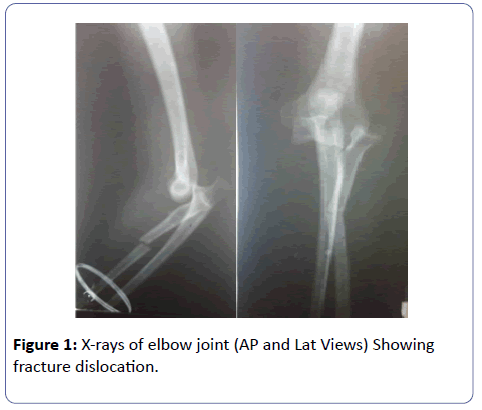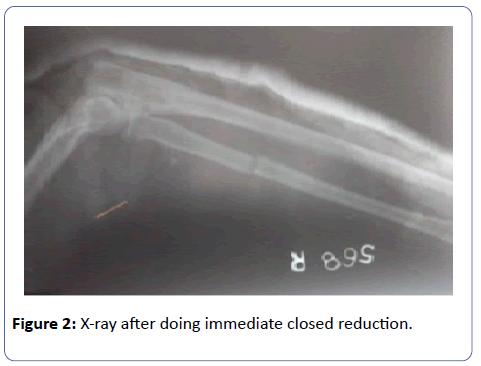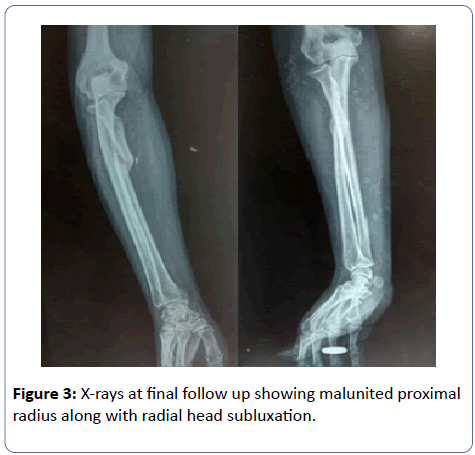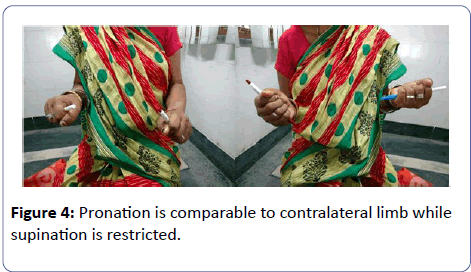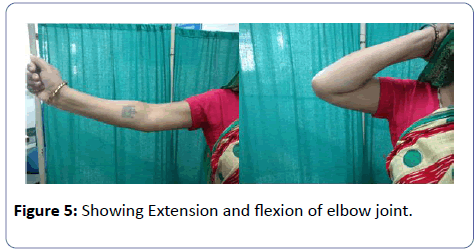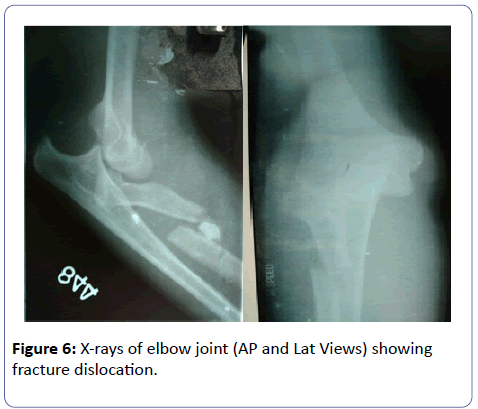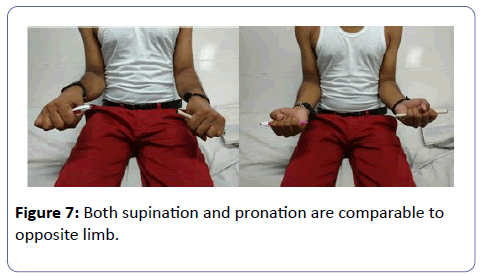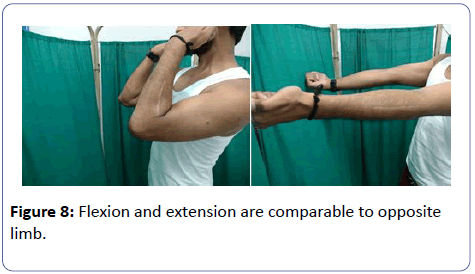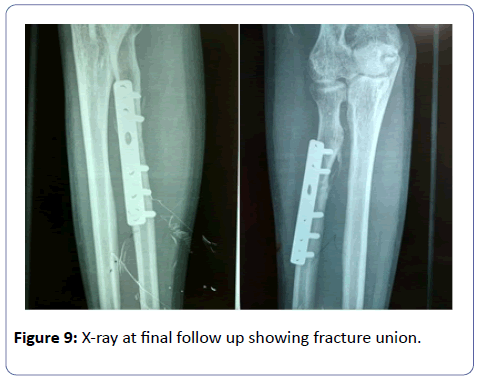Complex Elbow Dislocation with Ipsilateral Proximal Third Radius Fracture: Comparison of Outcome of Two Cases Managed Differently
Mohit KA, Madaan E
DOI10.4172/2471-8416.100035
Mohit KA* and Madaan E
Department of Orthopaedics, Guru Teg Bahadur Hospital, New Delhi, India
- *Corresponding Author:
- Mohit Kumar Arora
Department of Orthopaedics, Guru Teg Bahadur Hospital
New Delhi, India
Tel: +91-9013490058
Email: drmkarora@yahoo.com
Received date: February 18, 2017; Accepted date: April 19, 2017; Published date: April 24, 2017
Citation: Mohit KA, Madaan E (2017) Complex Elbow Dislocation with Ipsilateral Proximal Third Radius Fracture: Comparison of Outcome of Two Cases Managed Differently. J Clin Exp Orthop 3:35. doi:10.4172/2471-8416.100035
Copyright: © 2017 Mohit KA, et al. This is an open-access article distributed under the terms of the Creative Commons Attribution License, which permits unrestricted use, distribution, and reproduction in any medium, provided the original author and source are credited.
Abstract
Complex elbow dislocation along with ipsilateral proximal third radius fracture is a very rare combination. We present two such cases that were managed differently. The elbow dislocation can be managed by closed means but clearly, there is superiority of open reduction when compared to closed reduction while managing fracture radius.
Keywords
Elbow dislocation; Ipsilateral; Forearm; Radius
Introduction
Elbow joint is one of the most commonly joint to get dislocated. If there is only dislocation of ulno-humeral joint without fracture, it is called simple elbow dislocation. If the elbow dislocation is associated with fracture of humerus, ulna or radius either alone or in combination, it is termed as complex elbow dislocation. We present two cases of complex elbow dislocation associated with fracture proximal third radius ipsilaterally. Both the cases were managed differently. We will compare the results of both.
Case Presentation 1
A 40 year old female sustained injury to her right dominant elbow in the form of fall from bike. She presented to Orthopaedic emergency in our institution. There was no history of loss of consciousness, ENT bleed, seizure or vomiting. The patient was conscious and oriented at the time of presentation. Local examination revealed tenderness, swelling and deformity at elbow region. There was no distal neuro vascular deficit. Radiological examination revealed elbow dislocation with fracture proximal third radius (Figure 1).
Closed reduction was done (Figure 2) and splintage applied and patient was counselled for surgery. However patient did not opt for surgery and did not come for follow up (Figure 2).
After one year, she again visited GTB hospital for some unrelated complaints. Supination of forearm is from 0-50° and Pronation is comparable to contralateral limb while flexion at elbow is from 10°-120°.
Patient is able to do most of her daily activities. The fracture has united clinico-radiologically (Figures 3-5).
Case Presentation 2
A 25 year old male sustained injury to his left elbow joint. Patient fell from table on his left hand with elbow in full extension. There was no history of loss of consciousness, ENT bleed, seizure or vomiting. The patient was conscious and oriented at the time of presentation. Local examination revealed tenderness, swelling and deformity at elbow region. There was no distal neuro vascular deficit. Radiological examination (Figure 6) revealed elbow dislocation with fracture proximal third radius (Figure 6).
Closed reduction was done and splintage applied and patient was counselled for surgery. Patient underwent ORIF using Thompson approach with 6 hole DCP. Post op period was uneventful. The patient was started on Range of motion exercises 2 weeks after surgery. At the last follow up, the fracture has united clinico-radiologically and all the movements are comparable to the opposite limb (Figures 7-9).
Discussion
The elbow joint comprises of articulation of humerus with radius and ulna. The ulno-humeral is hinge joint while humeroradial is a ball and socket type of joint. The various articulations and collateral ligaments provides stability to the joint [1]. Fractures of forearm bones associated with elbow dislocation commonly occur around the elbow, i.e., in the proximal part and involve the radial head, olecranon, and coronoid process [2]. There are some case reports of elbow dislocation with ipsilateral both bone diaphyseal fracture [3,4] but the combination of elbow dislocation with ipsilateral fracture of proximal third radius is very rare. The literature search shows only one case described with this pattern of injury [5].
The mechanism of injury to cause elbow dislocation is typical fall onto an outstretched hand with elbow in full extension upon impact. However, in our cases there was additional fracture of proximal third radius as well as superior radio-ulnar joint dislocation. The sequence of events leading to such injury are described. Both the patient had history of fall on outstretched hand with elbow in full extension. The axial force must have travelled from hand to radius leading to fracture of proximal shaft along with superior radio-ulnar joint disruption. Then the force must have travelled to ulna leading to elbow dislocation.
Our case report compares the outcome of two cases with same pattern of injury managed differently and clearly demonstrates the superiority of ORIF over conservative management in this type of injury.
Conclusion
Complex elbow dislocation with fracture proximal third radius is a very rare injury pattern. Thorough clinico-radiological examination should be done. This type of injury can be managed by closed reduction of elbow and open reduction of radius to obtain good functional outcome.
References
- Bryce CD, Armstrong AD (2008) Anatomy and biomechanics of the elbow. Orthop Clin North Am 39: 141-154.
- Ring D, Jupiter JB (1998) Fracture-dislocation of the elbow. J Bone Jt Surg Am 80: 566-580.
- Madhar M, Saidi H, Fikry T, Cermak K, Moungondo F, et al. (2013) Dislocation of the elbow with ipsilateral forearm fracture. Six particular cases. Chir Main 32: 299-304.
- Goni V, Behera P, Meena UK, Gopinathan Nr, Akkina N, et al. (2015) Elbow dislocation with ipsilateral diaphyseal forearm bone fracture: a rare injury report with literature review. Chin J Traumatol 18: 113-115.
- Mishra D, Cheema G, Yadav V (2010) Transverse dislocation of the elbow with ipsilateral shaft of radius fracture in an adult. Eur J Trauma Emerg Surg 36: 601-603.
Open Access Journals
- Aquaculture & Veterinary Science
- Chemistry & Chemical Sciences
- Clinical Sciences
- Engineering
- General Science
- Genetics & Molecular Biology
- Health Care & Nursing
- Immunology & Microbiology
- Materials Science
- Mathematics & Physics
- Medical Sciences
- Neurology & Psychiatry
- Oncology & Cancer Science
- Pharmaceutical Sciences
